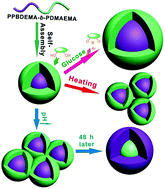Functional micelles formed from glucose-, thermo- and pH-triple responsive copolymers for controlled release
Abstract
A glucose-, thermo-, and pH-triple responsive copolymer, poly(2-phenylboronic esters-1,3-dioxane-5-ethyl) methylacrylate-b-poly(2-(N,N-dimethylamino)ethyl methacrylate) (PPBDEMA-b-PDMAEMA), was synthesized through atom transfer radical polymerization (ATRP). Benefiting from its amphiphilicity, PPBDEMA-b-PDMAEMA could self-assemble in water into micelles with the PPBDEMA core and the PDMAEMA shell. Glucose would react with PPBDEMA, leading to the expansion of the micelles. Because of the thermo-responsive PDMAEMA segment, increasing temperature would cause the PDMAEMA shell to shrink and the micelles to aggregate. Both PPBDEMA and PDMAEMA segments were found to have pH-responsive properties, but PDMAEMA responded faster than PPBDEMA upon pH stimulus. When the pH value was high (>8), the original copolymer micelles would disassemble and new micelles with the PPBDEMA shell and the PDMAEMA core would form after 48 h. PPBDEMA-b-PDMAEMA copolymer micelles could be used as smart carriers to achieve the multi-controlled release of insulin and Nile red fluorescent dye molecules by adjusting the temperature, the pH value, and the glucose concentration. The release rate of insulin from the micelles at high glucose concentrations was much faster than that at lower glucose concentrations at the physiological pH value and could be further accelerated by heating. Meanwhile, increasing the temperature, the pH value, and the glucose concentration would increase the release rate of Nile red from the micelles.



 Please wait while we load your content...
Please wait while we load your content...